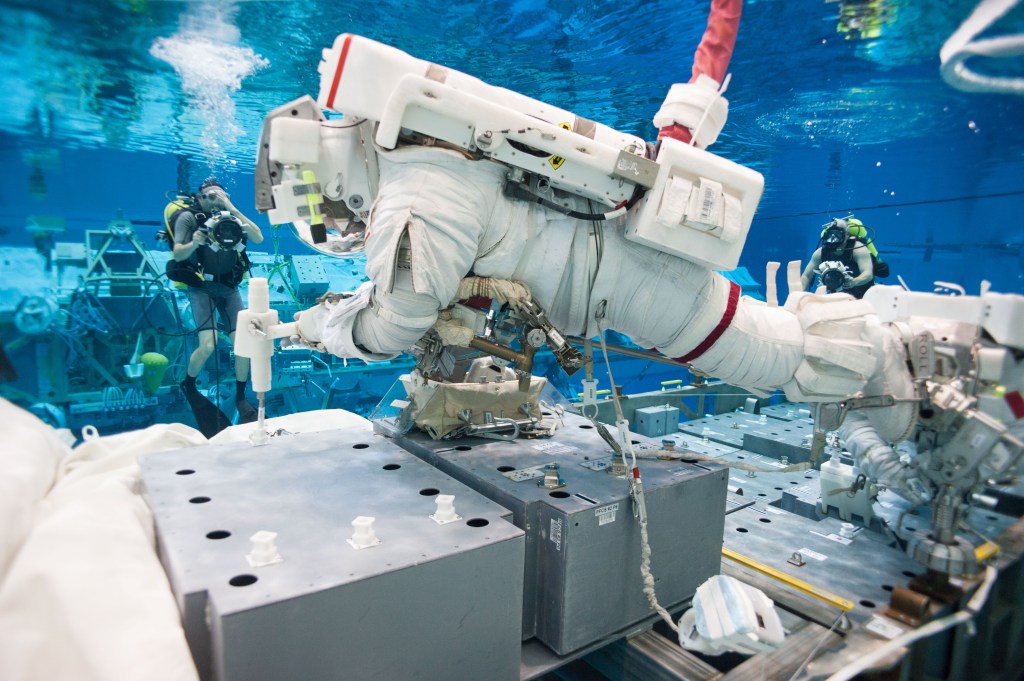Appendix C : Definitions

Contents
C.1 PURPOSE
This Appendix provides guidance, made available in the definitions listed below.
C.2 Definitions
A-B
As low as (is) reasonably achievable (ALARA):
Making every reasonable effort to maintain exposures to ionizing radiation as far below the dose limits as practical, consistent with the purpose for which the licensed activity is undertaken, taking into account the state of technology, the economics of improvements in relation to state of technology, the economics of improvements in relation to benefits to the public health and safety, and other societal and socioeconomic considerations, and in relation to utilization of nuclear energy and licensed materials in the public interest.
Aerobic Fitness:
The ability to perform dynamic exercise that involves large muscle groups at a moderate to high intensity for prolonged periods.
Astronaut:
An individual selected and trained to travel into space and to monitor, operate, and control parts of, or the whole space system to complete mission objectives. Also see Crewmember.
Barotrauma:
Injuries caused by changes in pressure.
Bisphosphonates:
A group of medicines that slows own or prevent bone loss, preserving bone strength.
Bone Mineral Density (BMD):
The amount of mineral content per unit volume of bone.
Areal Bone Mineral Density (aBMD):
The amount of mineral content per unit area of bone (g/cm2) which indicates how BMD compares to that of a healthy 30-year-old. Peak bone density is reached by age 30 and ideally be maintained at this level throughout life. As BMD decreases from this peak density, fracture risk could increase. The T-score is in units of standard deviations (SD) and shows whether bones are more dense (+) or less dense (-) than those of a 30 year old. A T-score of -1.0 or above is normal bone density, between -1.0 and -2.5 means low bone density or osteopenia, and a T-score of -2.5 or below is a diagnosis of osteoporosis.
C-D
Career Dose:
The amount of radiation dose received by a crewmember over the course of their career.
Circadian Misalignment:
Desynchronization between the timing of the master circadian pacemaker in the suprachiasmatic nucleus (SCN) of the hypothalamus and sleep wake timing or desynchronization between the SCN and peripheral oscillators, such as those in the gut, liver, and reproductive organs.
Circadian Rhythm:
The natural cycle of physical, mental, and behavior changes that the body goes through in a 24-hour cycle.
Cognitive Function:
Any mental process that involves symbolic operations. Cognitive function encompasses awareness and capacity for judgment.
Crew:
Team of two or more crewmembers assigned to a mission that have been trained to monitor, operate, and control parts of, or the whole space system.
Crew Medical Officer:
Crewmember who has been assigned as a medical expert for a particular mission.
Crewmember:
An individual member of a crew. Also see Astronaut.
Definitive Medical Care Facility (DMCF):
An inpatient medical facility capable of comprehensive diagnosis and treatment of a crewmember’s injuries or illness. DMCFs are trauma-capable facilities; ideally, such facilities should be capable of managing (per the American College of Surgeons’ definitions) Category I, II, and III trauma patients. In an off-nominal landing location, depending on regional resources, a facility with more limited capabilities may be considered a DMCF if able to manage crewmember medical needs. Interim treatment locations, such as a recovery ship, field triage station, or lower capability medical facility, may be utilized for stabilization until transport to a DMCF is possible.
Depressurization:
Reducing the pressure of air or gas within a suit, chamber, or vehicle.
Dual-energy X-ray absorptiometry (DXA):
An x-ray-based test that measures bone mineral in a 2D projected image of bone tissue.
Dysbarism:
Any adverse medical condition that results from changes in ambient pressure. These changes in pressure must occur either at a rate or duration exceeding the capacity of the body to adapt safely.
E-F
Effective Dose:
The tissue-weighted sum of the equivalent doses in all specified tissues and organs of the human body and represents the stochastic health risk to the whole body, which is the probability of cancer induction and genetic effects, of low levels of ionizing radiation.
Environmental Control and Life Support (ECLSS):
A system designed to distribute air and remove contaminants. The elements include all hardware, software, equipment, facilities, personnel, processes, and procedures needed for this purpose.
Estimated Mission Radiation Dose:
Estimated amount of radiation dose for a particular design reference mission category (length of a mission, distance from Earth, etc.).
Exercise:
Any bodily activity that enhances or maintains physical fitness and overall health and wellness. Exercise is used to maintain or minimize loss of crewmember muscle mass and cardiovascular fitness, to maintain muscle strength/endurance, for recovery from strenuous tasks and confined postures, to rehabilitate minor muscle injuries, and to maintain bone mass. Exercise also has behavioral health benefits.
Extravehicular Activity:
Operations performed by suited crew outside the pressurized environment of a flight vehicle or habitat (during spaceflight or on a destination surface). Includes contingency operations performed inside unpressurized vehicles or habitats.
Fitness for Duty (FFD):
Minimum measurable capability or capacity for a given physiological or behavioral parameter that allows successful performance of all required duties.
Free-space:
vehicle location is far enough from a celestial body such that the combined effects from terrestrial, atmospheric, and magnetic shielding can be ignored.
G-L
Galactic Cosmic Rays (GCR):
Originates outside the solar system. It consists of ionized atoms ranging from a single proton up to a uranium nucleus. The flux (rate of flow) levels of these particles is very low. However, since they travel very close to the speed of light, and because some of them are composed of very heavy elements such as iron, they produce intense ionization as they pass through matter.
Gravity Transitions (G-transition):
Physiological effects caused by changes in gravitational forces, alternating between hypogravity (<1GZ) and hypergravity (>1GZ).
Hypothermia:
A medical emergency that occurs when the body loses heat faster than it can produce heat, causing a dangerously low body temperature. Normal body temperature is around 98.6ºF (37ºC). Hypothermia occurs as your body temperature falls below 95ºF (35ºC).
Hypoxia:
A deficiency of oxygen reaching the tissues of the body.
Incapacitation/Crew Rescue:
Injuries sustained by a crewmember during an extravehicular activity that prevent the affected crewmember from continuing independent operations, and which would require support from other suited crew to avert mission level outcomes.
In-Mission:
All phases of the mission, from launch, through landing on a planetary body and all surface activities entailed, up to landing back on Earth.
Insomnia:
Dissatisfaction with sleep quantity or quality, associated with one (or more) of the following symptoms: Difficulty initiating sleep or maintaining sleep, characterized by frequent awakenings or problems returning to sleep after awakenings.
Linear Energy Transfer (LET):
The average amount of energy imparted to a material by an ion per unit path length traveled by the ion. The LET of an energetic ion, weighted by a radiation “quality factor,” is used in regulatory standards as a relative measure of biological effectiveness for harm resulting from ionizing radiation exposures.
M-R
Maximum VO2 (VO2max):
The maximum amount of oxygen the body can utilize during a specified period of usually intense exercise.
Medications:
A pharmaceutical or other substance used for medical diagnosis, prevention, or treatment.
Nutrients:
Nutrients are substances that provide the body with the nourishment essential for growth and maintenance of life.
Nutrient Deficiencies:
Nutrient deficiencies occur when the body is not getting enough nutrients to support normal physiological system function.
Palliative Care:
Specialized medical care that focuses on providing patients relief from pain and other symptoms of a serious illness, no matter the diagnosis or stage of disease. Palliative care teams aim to improve the quality of life for both patients and their families.
Permissible Outcome Limits (POL):
Acceptable maximum decrement or change in a physiological or behavioral parameter, during or after a spaceflight mission, as the result of exposure to the space environment. Biological/clinical parameter measured, e.g., bone mineral density.
Probabilistic Risk Assessment (PRA):
A comprehensive, structured, and disciplined approach to identifying and analyzing risk by seeking answers to three basic questions: what can go wrong, how likely is it, and what are its consequences? (Derived from ESD 10011)
Relative Biological Effectiveness (RBE):
A term used to compare how damaging radiation is, using x-rays or gamma rays as a reference. A radiation that is 10 times more effective per unit dose than X-rays would have an RBE of 10. RBE varies with dose, dose rate, and measured endpoint among other factors.
S-W
Schedule:
Arrange, control, and optimize work and workloads to facilitate crew timeline of activities.
Sievert:
A derived (not directly measured) unit of dose equivalent or NASA equivalent dose of radiation which accounts for the biological effect (radiation quality and tissue sensitivity) of ionizing radiation in reference to carcinogenic potential. 1 Sv = 1000 millisieverts (mSv).
Solar Particle Event (SPE):
Injections of energetic electrons, protons, alpha particles, and heavier particles into interplanetary space. These particles are accelerated to near relativistic speeds by the interplanetary shock waves which precede fast coronal mass ejections, and which exist in the vicinity of solar flare sites. The most energetic particles arrive at Earth within tens of minutes of the event on the Sun, while the lower-energy population arrives over the course of a day. They temporarily enhance the radiation in interplanetary space around the magnetosphere, and they may penetrate to low altitudes in the polar regions.
Space Permissible Exposure Limits (SPEL):
Quantifiable limit of exposure to a spaceflight factor over a given length of time, e.g., lifetime radiation exposure.
Space System:
The collection of all space-based and ground-based systems (encompassing hardware and software) used to conduct space missions or support activity in space, including, but not limited to, the crewed space system, space-based communication and navigation systems, launch systems, and mission/launch control. Also referred to as “system” in the technical requirements.
TREAT (To Research, Evaluate, Assess, and Treat) Astronauts Act:
Authorizes NASA to monitor and diagnose potential conditions and treat conditions associated with spaceflight. It is a comprehensive program of monitoring, diagnosis, and treatment services provided to current and former United States Government astronauts.
Toxic Exposure:
Contact with agents or substances in the interior of the spacecraft or spacesuit that can affect the health and performance of the crewmembers.
Training:
The act of undertaking a course of instruction in skills, knowledge or fitness that relate to specific competencies needed for spaceflight missions. Training has specific goals of improving an individual or team’s capability, capacity, and performance.
Ultrasound:
An imaging modality to examine the internal organs using very high frequency sound waves.
Workload:
Level of demand placed on a crewmember’s physical, cognitive, and/or temporal resources in a unit of time.




























